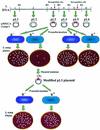New restriction enzymes discovered from Escherichia coli clinical strains using a plasmid transformation method
- PMID: 12595571
- PMCID: PMC149844
- DOI: 10.1093/nar/gng022
New restriction enzymes discovered from Escherichia coli clinical strains using a plasmid transformation method
Abstract
The presence of restriction enzymes in bacterial cells has been predicted by either classical phage restriction-modification (R-M) tests, direct in vitro enzyme assays or more recently from bacterial genome sequence analysis. We have applied phage R-M test principles to the transformation of plasmid DNA and established a plasmid R-M test. To validate this test, six plasmids that contain BamHI fragments of phage lambda DNA were constructed and transformed into Escherichia coli strains containing known R-M systems including: type I (EcoBI, EcoAI, Eco124I), type II (HindIII) and type III (EcoP1I). Plasmid DNA with a single recognition site showed a reduction of relative efficiency of transformation (EOT = 10(-1)-10(-2)). When multiple recognition sites were present, greater reductions in EOT values were observed. Once established in the cell, the plasmids were subjected to modification (EOT = 1.0). We applied this test to screen E.coli clinical strains and detected the presence of restriction enzymes in 93% (14/15) of cells. Using additional subclones and the computer program, RM Search, we identified four new restriction enzymes, Eco377I, Eco585I, Eco646I and Eco777I, along with their recognition sequences, GGA(8N)ATGC, GCC(6N)TGCG, CCA(7N)CTTC, and GGA(6N)TATC, respectively. Eco1158I, an isoschizomer of EcoBI, was also found in this study.
Figures







Similar articles
-
Characterization of a restriction modification system from the commensal Escherichia coli strain A0 34/86 (O83:K24:H31).BMC Microbiol. 2008 Jun 27;8:106. doi: 10.1186/1471-2180-8-106. BMC Microbiol. 2008. PMID: 18588664 Free PMC article.
-
The recognition and modification sites for the bacterial type I restriction systems KpnAI, StySEAI, StySENI and StySGI.Nucleic Acids Res. 2004 Jun 15;32(10):e82. doi: 10.1093/nar/gnh079. Nucleic Acids Res. 2004. PMID: 15199175 Free PMC article.
-
Quick identification of Type I restriction enzyme isoschizomers using newly developed pTypeI and reference plasmids.Nucleic Acids Res. 2008 Aug;36(13):e81. doi: 10.1093/nar/gkn056. Epub 2008 Jun 18. Nucleic Acids Res. 2008. PMID: 18562466 Free PMC article.
-
Mechanistic insights into type III restriction enzymes.Front Biosci (Landmark Ed). 2012 Jan 1;17(3):1094-107. doi: 10.2741/3975. Front Biosci (Landmark Ed). 2012. PMID: 22201792 Review.
-
The biology of restriction and anti-restriction.Curr Opin Microbiol. 2005 Aug;8(4):466-72. doi: 10.1016/j.mib.2005.06.003. Curr Opin Microbiol. 2005. PMID: 15979932 Review.
Cited by
-
The run-on oligomer filament enzyme mechanism of SgrAI: Part 1. Assembly kinetics of the run-on oligomer filament.J Biol Chem. 2018 Sep 21;293(38):14585-14598. doi: 10.1074/jbc.RA118.003680. Epub 2018 Aug 1. J Biol Chem. 2018. PMID: 30068553 Free PMC article.
-
Impact of target site distribution for Type I restriction enzymes on the evolution of methicillin-resistant Staphylococcus aureus (MRSA) populations.Nucleic Acids Res. 2013 Aug;41(15):7472-84. doi: 10.1093/nar/gkt535. Epub 2013 Jun 14. Nucleic Acids Res. 2013. PMID: 23771140 Free PMC article.
-
Burkholderia pseudomallei sequencing identifies genomic clades with distinct recombination, accessory, and epigenetic profiles.Genome Res. 2015 Jan;25(1):129-41. doi: 10.1101/gr.177543.114. Epub 2014 Sep 18. Genome Res. 2015. PMID: 25236617 Free PMC article.
-
DNA methylation by three Type I restriction modification systems of Escherichia coli does not influence gene regulation of the host bacterium.Nucleic Acids Res. 2021 Jul 21;49(13):7375-7388. doi: 10.1093/nar/gkab530. Nucleic Acids Res. 2021. PMID: 34181709 Free PMC article.
-
KpnBI is the prototype of a new family (IE) of bacterial type I restriction-modification system.Nucleic Acids Res. 2004 Oct 8;32(18):e138. doi: 10.1093/nar/gnh134. Nucleic Acids Res. 2004. PMID: 15475385 Free PMC article.
References
-
- Arber W. and Linn,S. (1969) DNA modification and restriction. Annu. Rev. Biochem., 38, 467–500. - PubMed
-
- Redaschi N. and Bickle,T.A. (1996) DNA restriction and modification systems. In Neidhardt,F.C. (ed.), Escherichia coli and Salmonella typhimurium: Cellular and Molecular Biology. ASM Press, Washington, DC, pp. 773–781.
Publication types
MeSH terms
Substances
LinkOut - more resources
Full Text Sources
Other Literature Sources
Molecular Biology Databases

